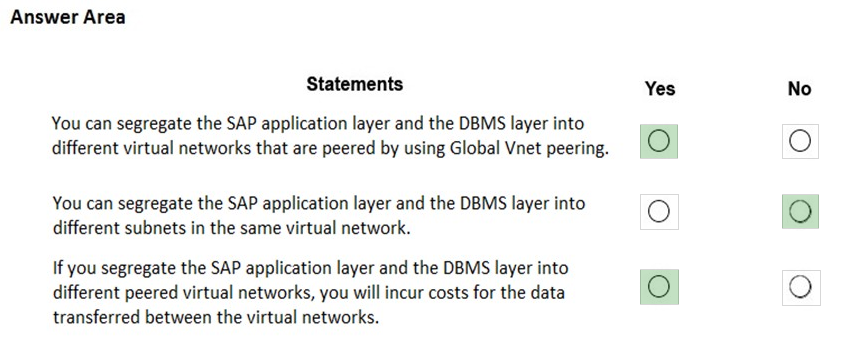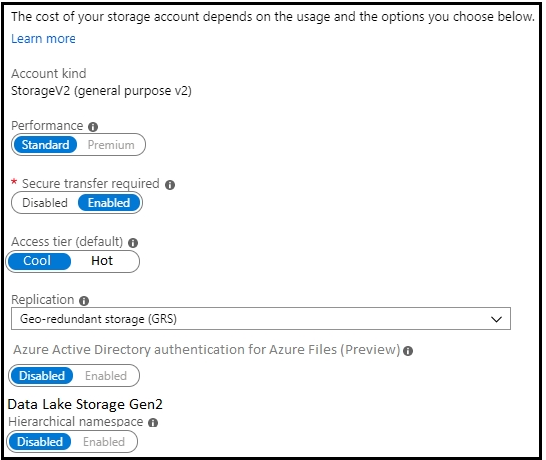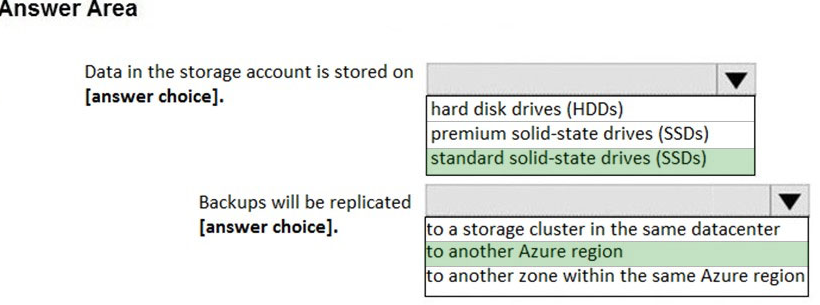microsoft az-120 practice test
planning and administering microsoft azure for sap workloads
Question 1
HOTSPOT You are planning the Azure network infrastructure for an SAP environment.
For each of the following statements, select Yes if the statement is true. Otherwise, select No.
NOTE: Each correct selection is worth one point.
Hot Area:
Answer:

Box 1: Yes -
Box 2: No -
A design that's not supported is the segregation of the SAP application layer and the DBMS layer into different Azure virtual networks that aren't peered with each other. We recommend that you segregate the SAP application layer and DBMS layer by using subnets within an Azure virtual network instead of by using different
Azure virtual networks.
Box 3: Yes -
Be aware that network traffic between two peered Azure virtual networks is subject to transfer costs. Huge data volume that consists of many terabytes is exchanged between the SAP application layer and the DBMS layer. You can accumulate substantial costs if the SAP application layer and DBMS layer are segregated between two peered Azure virtual networks.
Reference:
https://docs.microsoft.com/en-us/azure/virtual-machines/workloads/sap/dbms_guide_general
Question 2
Note: This question is part of a series of questions that present the same scenario. Each question in the series contains a unique solution that might meet the stated goals. Some question sets might have more than one correct solution, while others might not have a correct solution.
After you answer a question in this section, you will NOT be able to return to it. As a result, these questions will not appear in the review screen.
You deploy SAP HANA on Azure (Large Instances).
You need to back up the SAP HANA database to Azure.
Solution: Back up directly to disk, copy the backups to an Azure virtual machine, and then copy the backup to an Azure Storage account.
Does this meet the goal?
- A. Yes
- B. No
Answer:
b
Question 3
This question requires that you evaluate the underlined text to determine if it is correct.
You are planning for the administration of resources in Azure.
To meet the technical requirements, you must first implement Active Directory Federation Services (AD FS).
Instructions: Review the underlined text. If it makes the statement correct, select `No change is needed`. If the statement is incorrect, select the answer choice that makes the statement correct.
- A. No change is needed
- B. Azure AD Connect
- C. Azure AD join
- D. Enterprise State Roaming
Answer:
a
The SAP Cloud Platform Identity Authentication and Active Directory Federation Services enable you to implement SSO across applications or services that are protected by Azure AD (as an IdP) with SAP applications and services that are protected by SAP Cloud Platform Identity Authentication.
Scenario: Use Active Directory accounts to administer Azure resources.
Incorrect Answers:
Not D: With Windows 10, Azure Active Directory (Azure AD) users gain the ability to securely synchronize their user settings and application settings data to the cloud. Enterprise State Roaming provides users with a unified experience across their Windows devices and reduces the time needed for configuring a new device. Enterprise State Roaming operates similar to the standard consumer settings sync that was first introduced in Windows 8.
References:
https://docs.microsoft.com/en-us/azure/active-directory/saas-apps/sap-hana-cloud-platform-identity-authentication-tutorial
Question 4
You have an SAP on Azure production landscape that is hosted on Standard M-series virtual machines.
You plan to expand the storage on the virtual machines.
Which type of disk can be expanded without causing downtime?
- A. Ultra
- B. Standard SSD
- C. Premium SSD v2
- D. Premium SSD v1
Answer:
b
Question 5
You have an Azure subscription that contains two SAP HANA on Azure (Large Instances) deployments named HLI1 and HLI2. HLI1 is deployed to the East US Azure region. HLI2 is deployed to the West US 2 Azure region.
You need to minimize network latency for inter-region communication between HLI1 and HLI2.
What should you implement?
- A. a NAT gateway
- B. IP routing tables
- C. ExpressRoute FastPath
- D. ExpressRoute Global Reach
Answer:
d
Question 6
HOTSPOT You are designing the backup for an SAP database.
You have an Azure Storage account that is configured as shown in the following exhibit.
Use the drop-down menus to select the answer choice that completes each statement based on the information presented in the graphic.
NOTE: Each correct selection is worth one point.
Hot Area:
Answer:

Box 1: standard solid-state drives (SSDs)
Standard SSD Managed Disks, a low-cost SSD offering, are optimized for test and entry-level production workloads requiring consistent latency.
Box 2: to another Azure region -
Geo-redundant storage (GRS) copies your data synchronously three times within a single physical location in the primary region using LRS. It then copies your data asynchronously to a single physical location in a secondary region that is hundreds of miles away from the primary region.
References:
https://azure.microsoft.com/en-us/pricing/details/managed-disks/ https://docs.microsoft.com/en-us/azure/storage/common/storage-redundancy#geo-redundant-storage
Question 7
You have an Azure subscription. The subscription contains a virtual machine named VM1 that runs SAP HANA and a user named User1. User1 is assigned the Virtual Machine Contributor role for VM1.
You need to prevent User1 from placing VM1 in the Stopped (deallocated) state. User1 must be able to restart the operating system on VM1.
What should you do?
- A. Create a resource lock on VM1.
- B. Assign an Azure Policy definition to the resource group that contains VM1.
- C. Assign User1 the Virtual Machine User Login role for VM1.
- D. Configure the Desired State Configuration (DSC) extension on VM1.
Answer:
a
Question 8
You have an instance of Azure SAP HANA (Large Instances) named HLI1 that has storage volume snapshots enabled.
You need to monitor the storage usage of HLI1. The solution must monitor the following:
The number of stored snapshots
The storage used by the snapshots
Which Linux OS command should you use?
- A. hdbuserstore
- B. ls
- C. du
- D. sapcontrol
Answer:
b
Question 9
This question requires that you evaluate the underlined text to determine if it is correct.
When deploying SAP HANA to an Azure virtual machine, you can enable Write Accelerator to reduce the latency between the SAP application servers and the database layer.
Instructions: Review the underlined text. If it makes the statement correct, select `No change is needed`. If the statement is incorrect, select the answer choice that makes the statement correct.
- A. No change is needed
- B. install the Mellanox driver
- C. start the NIPING service
- D. enable Accelerated Networking
Answer:
d
To further reduce network latency between Azure VMs, we [Microsoft] recommend that you choose Azure Accelerated Networking. Use it when you deploy Azure
VMs for an SAP workload, especially for the SAP application layer and the SAP DBMS layer.
Incorrect Answers:
A: Write Accelerator is a disk capability for M-Series Virtual Machines (VMs) on Premium Storage with Azure Managed Disks exclusively. As the name states, the purpose of the functionality is to improve the I/O latency of writes against Azure Premium Storage.
B: Mellanox offers a robust and full set of protocol software and driver for Linux with the ConnectX EN family cards. Designed to provide a high performance support for Enhanced Ethernet with fabric consolidation over TCP/IP based LAN applications. The driver and software in conjunction with the Industry's leading
ConnectX family of cards achieve full line rate, full duplex of up to 100Gbps performance per port.
C: To analyze network issue or measure network metrics you can test the connection using SAP's NIPING program. You can use NIPING to analyze the network connection between any two machines running SAP software.
Reference:
https://docs.microsoft.com/en-us/azure/virtual-machines/workloads/sap/dbms_guide_general
Question 10
You have an SAP landscape on Azure that contains the virtual machines shown in the following table.
You need to ensure that the Application Server role is available if a single Azure datacenter fails.
What should you include in the solution?
- A. Azure Basic Load Balancer
- B. Azure Load Balancer Standard
- C. Azure Virtual WAN
- D. Azure Application Gateway v1
Answer:
b